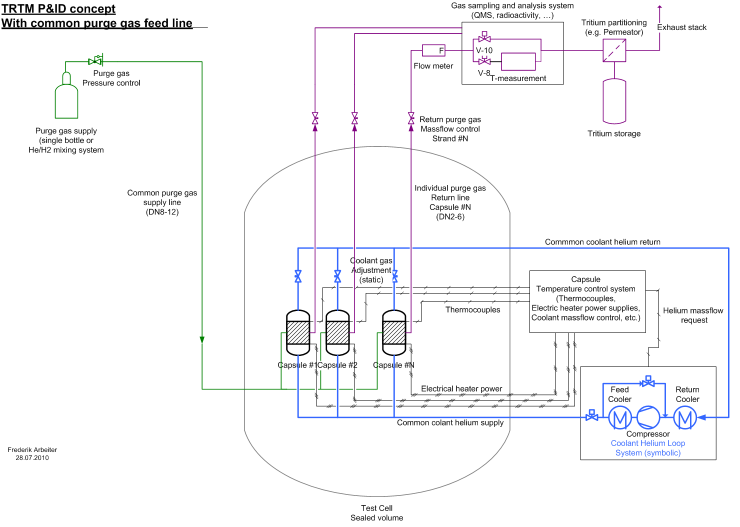Gas Composition Analysis and Control
Helium gas is considered as a coolant or purge gas for many high temperature components both in nuclear fusion and fission technology. In such facilities, gas purification (or more general, conditioning) is of concern. Gaseous contaminants, such as the components of ambient air, water, or products of nuclear reactions (i.e., Tritium), can enter the coolant media. Therefore, activities concerning the gas contaminants in coolant loops are pursued at INR. Elements of these activities are:
- Analysis methods for trace gases in helium carrier gas
- Determination of contaminant source and sink terms for system components
- Dynamic modelling of the gas composition on the system scale
In essence, the goal is to provide validated tools for gas composition evolution prediction in nuclear energy cooling systems. Such a tool can be the basis for the dimensioning of purification systems and for safety considerations. Since the gas composition, and the necessary measures for its conditioning affect lifetime, safety and availability of the systems, correct predictions will help to improve the overall economics of the power plant or experimental facilities.
Component Permeation and Leakage Tests (COMPLETE)
Industrially available components, especially gaskets and flanges, are tested for tightness against helium effluence and contaminants ingress. The pressure conditions and temperatures are varied. Results are input to the contaminant source terms of the plant contamination prediction.
Helium trace gas analysis
In-Situ, online and off-line (sample taking) methods for contaminants determination in helium carrier gas are implemented and tested. The reliability and error margins of different measurement methods will be characterized. Both high pressure (HELOKA-HP) and low pressure (HELOKA-LP) helium loops are equipped with quadrupole mass spectrometers. Alternative measurement methods (ZrO2 oxygen probes, dewpoint hygrometers, IR spectrometers) are used for complementary measurements.
 |
| Quadrupole mass spectrometer workstation for helium trace gas analysis, analysis results for bottled Helium (4.6) using online and offline sampling methods |
Hydrogen isotope separation
The separation of hydrogen from helium carrier gas by palladium permeators (developed at ITP / Tritium Laboratory Karlsruhe, KIT) is experimentally studied at very low hydrogen partial pressures, for application in the IFMIF testcell environment.
IFMIF tritium release test module (TRTM)
The IFMIF TRTM is an experiment to study the generation and release of tritium in breeder materials (Lithium orthosilicate, Beryllium, etc.) under high energy neutron irradiation. The task includes the module design, the study of tritium migration in the module and the periphery, as well as the design of the gas analysis system.
 |
| Study of the process diagram for the IFMIF Tritium Release Test Module |
Contact persons: Jana Freund, Frederik Arbeiter
